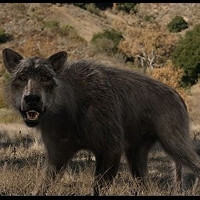The dire wolf became extinct somewhere between 4,000 and 16,000 years ago. This is thought to be partly due to its inability to compete with the faster, more intelligent gray wolf. It is the largest canid known to have ever existed. And while the gray wolf was similar in many ways, the dire wolf was heavier, more robust, with shorter, more powerful legs and a larger head.
Being a heavier animal with shorter legs, the dire wolf would have been slower and less able to catch prey than the gray wolf. It is therefore believed that the dire wolf was more of a scavenger than a predator. It did, however, know how to hunt when the opportunity arose. Its teeth were more massive and stronger, enabling it to consume carcasses with ease. Although his head was larger, his brain was smaller (a garbage collector doesn't need to outwit his prey). Plus, being larger, it would have had less competition.
A fossilized bone was discovered near the Ohio River in Indiana in 1854. However, it wasn't until years later that it was determined that this fossil belonged to an unknown wolf species. It was named Canis Dirus, the Dire Wolf. Thousands of canis dirus fossils were recovered from the tar pits of La Brea, Los Angeles, California, where water floated on the tar after rain. Trying to drink from the water pools, the animals are often trapped in the tar below. Wolves and other predators, trying to feed on trapped animals, would often be trapped in the tar themselves. Wolf fossils have been found in North, Central and South America. Their exact chain, however, is unknown. |







 English (United Kingdom)
English (United Kingdom)